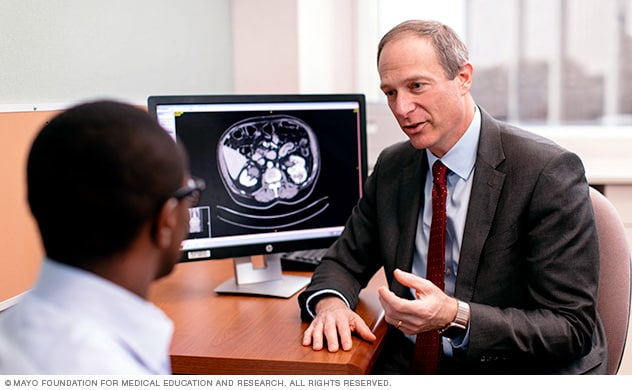In some cases men discover testicular cancer themselves, either unintentionally or while doing a testicular self-examination to check for lumps. In other cases, your doctor may detect a lump during a routine physical exam.
To determine whether a lump is testicular cancer, your doctor may recommend:
-
Ultrasound. A testicular ultrasound test uses sound waves to create an image of the scrotum and testicles. During an ultrasound you lie on your back with your legs spread. Your doctor then applies a clear gel to your scrotum. A hand-held probe is moved over your scrotum to make the ultrasound image.
An ultrasound test can help your doctor determine the nature of any testicular lumps, such as whether the lumps are solid or fluid-filled. An ultrasound also tells your doctor whether lumps are inside or outside of the testicle.
- Blood tests. Your doctor may order tests to determine the levels of tumor markers in your blood. Tumor markers are substances that occur normally in your blood, but the levels of these substances may be elevated in certain situations, including testicular cancer. A high level of a tumor marker in your blood doesn't mean you have cancer, but it may help your doctor in determining your diagnosis.
- Surgery to remove a testicle (radical inguinal orchiectomy). If it's determined that the lump on your testicle may be cancerous, surgery to remove the testicle may be recommended. Your removed testicle will be analyzed to determine if the lump is cancerous and, if so, what type of cancer.
Your extracted testicle will be analyzed to determine the type of testicular cancer. The type of testicular cancer you have determines your treatment and your prognosis. In general, there are two types of testicular cancer:
- Seminoma. Seminoma tumors occur in all age groups, but if an older man develops testicular cancer, it is more likely to be seminoma. Seminomas, in general, aren't as aggressive as nonseminomas.
- Nonseminoma. Nonseminoma tumors tend to develop earlier in life and grow and spread rapidly. Several different types of nonseminoma tumors exist, including choriocarcinoma, embryonal carcinoma, teratoma and yolk sac tumor.
Staging the cancer
Once your doctor confirms your diagnosis, the next step is to determine the extent (stage) of the cancer. To determine whether cancer has spread outside of your testicle, you may undergo:
- Computerized tomography (CT) scan. CT scans take a series of X-ray images of your abdomen, chest and pelvis. Your doctor uses CT scans to look for signs that cancer has spread.
- Blood tests. Blood tests to look for elevated tumor markers can help your doctor understand whether cancer likely remains in your body after your testicle is removed.
After these tests, your testicular cancer is assigned a stage. The stage helps determine what treatments are best for you. The stages of testicular cancer are:
- Stage I. Cancer is limited to the testicle.
- Stage II. Cancer has spread to the lymph nodes in the abdomen.
- Stage III. Cancer has spread to other parts of the body. Testicular cancer most commonly spreads to the lungs and liver.
Treatment
The options for treating your testicular cancer depend on several factors, including the type and stage of cancer, your overall health, and your own preferences.
Surgery
Explaining surgical options for testicular cancer
A Mayo Clinic urologist discusses surgical options for testicular cancer.
Operations used to treat testicular cancer include:
- Surgery to remove your testicle (radical inguinal orchiectomy) is the primary treatment for nearly all stages and types of testicular cancer. To remove your testicle, your surgeon makes an incision in your groin and extracts the entire testicle through the opening. A prosthetic, saline-filled testicle can be inserted if you choose. In cases of early-stage testicular cancer, surgical removal of the testicle may be the only treatment needed.
- Surgery to remove nearby lymph nodes (retroperitoneal lymph node dissection) is performed through an incision in your abdomen. Your surgeon takes care to avoid damaging nerves surrounding the lymph nodes, but in some cases harm to the nerves may be unavoidable. Damaged nerves can cause difficulty with ejaculation, but won't prevent you from having an erection.
If surgery is your only treatment for testicular cancer, your doctor will recommend a schedule of follow-up appointments. At these appointments — typically every few months for the first few years and then less frequently after that — you'll undergo blood tests, CT scans and other procedures to check for signs that your cancer has returned.
Radiation therapy
Radiation therapy uses high-powered energy beams, such as X-rays, to kill cancer cells. During radiation therapy, you're positioned on a table and a large machine moves around you, aiming the energy beams at precise points on your body.
Radiation therapy is a treatment option that's sometimes used in people who have the seminoma type of testicular cancer. Radiation therapy may be recommended after surgery to remove your testicle.
Side effects may include nausea and fatigue, as well as skin redness and irritation in your abdominal and groin areas. Radiation therapy is also likely to temporarily reduce sperm counts and may impact fertility in some men. Talk to your doctor about your options for preserving your sperm before beginning radiation therapy.
Chemotherapy
Chemotherapy treatment uses drugs to kill cancer cells. Chemotherapy drugs travel throughout your body to kill cancer cells that may have migrated from the original tumor.
Chemotherapy may be your only treatment, or it may be recommended before or after lymph node removal surgery.
Side effects of chemotherapy depend on the specific drugs being used. Ask your doctor what to expect. Common side effects include fatigue, nausea, hair loss and an increased risk of infection. There are medications and treatments available that reduce some of the side effects of chemotherapy.
Chemotherapy may also lead to infertility in some men, which can be permanent in some cases. Talk to your doctor about your options for preserving your sperm before beginning chemotherapy.
